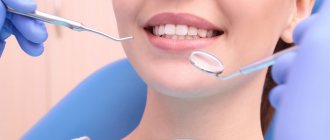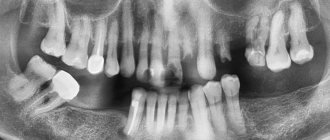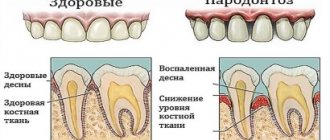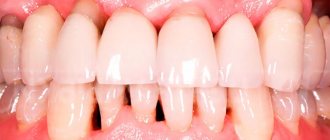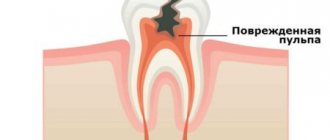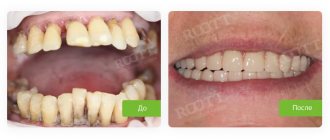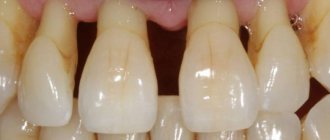Generalized periodontitis: symptoms and treatment
Periodontitis is a very common pathology of periodontal tissues (soft tissue structures around the dental unit). If the pathological process is started and left without treatment, then you can lose all the dental units.
Periodontal pockets are the best location for the emergence and development of an infectious process, which does not have the best effect on the healthy state of the body. A beautiful and healthy smile gives you self-confidence and makes you feel natural. When periodontal tissue is damaged, the gums become red and swollen. The disease affects the overall health of the body and the well-being of a person. If something bothers you in the oral cavity, you should immediately consult a specialist. Dentist therapists at the branches of the West Dental family clinic in Yanino-1 and Vsevolozhsk will help with identifying the origins of anxiety and their treatment.
It has been scientifically determined that the occurrence of periodontitis is influenced by: soft plaque and hard deposits; filling material or orthopedic structure fixed in violation of treatment protocols.
The main differences between acute and chronic periodontitis
Having considered the main characteristics of chronic and acute periodontitis, we can identify several main differences between these stages. Firstly, they differ in severity. Chronic periodontitis occurs slowly and often unnoticed by humans, while acute periodontitis is characterized by the suddenness and rapidity of damage to periodontal tissue.
Secondly, the factors that cause the disease vary significantly. Chronic periodontitis is caused mainly by general disturbances in the functioning of the body and bad habits, while the acute stage is provoked by mechanical damage to the teeth and gums due to injuries, certain types of dental diseases and improper installation of dentures.
Thirdly, the stages have different symptoms. If chronic periodontitis does not have a serious effect on the human body as a whole, then its acute form leads to intoxication, weakness, disrupting the usual course of life.
Fourthly, the localization of inflammation is somewhat different. In the chronic form, as a rule, the entire periodontium is affected to one degree or another, which is also typical for the acute non-purulent form. The acute purulent form is localized in a certain area of the oral cavity and leads to deepening of the periodontal pockets and significant swelling of the gums at the site of inflammation.
Fifthly, chronic and acute periodontitis require radically opposite measures of dental intervention. In the first case, regular preventative teeth cleaning at the dentist, treatment of the oral cavity with antiseptics to reduce the number of bacteria and relieve inflammation, physiotherapeutic procedures or treatment of periodontitis using the Vector apparatus are often sufficient. In the acute stage, it is often necessary not only to relieve inflammation, but also to remove a loose tooth, perform cavity surgery on the gums, or open the resulting fistulas and boils to remove pus. Patients often require consultation with an orthopedic dentist, who evaluates the possibility of installing dentures instead of extracted teeth.
Classification
According to the number of units affected by pathology:
- Catarrhal (localized) – 1-3 units in the affected area;
- Generalized – the entire dentition is affected.
According to the severity of generalized periodontitis (ICD code K05):
- Generalized mild periodontitis (ICD 10 code K05.3). This clinical diagnosis is made when the depth of the pockets in the gingival tissue is less than 3.5 mm, and less than 1/3 of the root is resorbed.
- Average. The subgingival depressions are 3.5-5 mm, and the bone is sclerosed at 50% of the root length.
- Severe degree. This stage is indicated by the depth of periodontal changes greater than 5 mm and resorption of more than 1/2 of the root.
Differential diagnosis according to pathogenesis:
- acute - more than one annual exacerbation;
- chronic generalized periodontitis (according to ICD K05) is an ongoing pathological process;
- exacerbation of chronic periodontitis – pain, discomfort, activation of the inflammatory process.
Classification of periodontitis.
The course of the disease, area of distribution and severity - these are the classification criteria.
According to the course of periodontitis there are:
- Spicy;
- Chronic;
- Periodontitis with abscess formation.
Periodontitis in the area of distribution can be local (focal) - individual parts of the periodontium are affected, and generalized (diffuse) - diffuse damage to the periodontal complex. The pathological process involves all periodontal tissues of one tooth, a group or all teeth: gums, circular ligament of the tooth, periodontal tissue, bone tissue (compact and spongy substance), the vascular system of these formations and the dental pulp.
According to its manifestation, periodontitis can be mild, moderate and severe.
The most important clinical sign of periodontitis is the presence of a periodontal pocket of varying depth (this can be used to judge the degree of damage).
The stronger the inflammation, the greater the pathological mobility of teeth becomes. As a rule, mobility is accompanied by the appearance of gaps between teeth and the overlap of one tooth over another. When determining the severity of periodontitis, the specialist evaluates the position of each tooth in the dental arch.
The degree of periodontal atrophy and the functional value of teeth underlie the choice of treatment for periodontitis.
Symptoms
The initial symptoms of the inflammatory process in periodontal tissues are the following:
- swelling of the gum tissue;
- severe bleeding during and after cleaning;
- throbbing severe pain.
As the pathology spreads, symptoms intensify:
- enlarged and painful lymph nodes;
- unpleasant odor from the mouth;
- mobility of dental units;
- increased sensitivity of tooth enamel;
- pain when biting and chewing food;
- deterioration of the general condition of the body;
- purulent discharge from periodontal pockets.
Chronic generalized periodontitis (beyond exacerbation) is characterized by:
- reddish color of gum tissue;
- exposure of tooth roots;
- Bone resorption is visually determined on the Rg image.
Chronic generalized periodontitis
Chronic generalized periodontitis (according to ICD 10-K05) affects the soft tissue and bone structures of all or more dental units. The frequency of occurrence is 5 times higher than carious lesions and its possible complications. Also, a generalized process can most likely lead to complete edentia (lack of teeth). The long-term location of the infectious process in periodontal tissues, without proper treatment, negatively affects the body's immune defense and can contribute to the development of rheumatoid arthritis, heart disease, etc. Generalized periodontitis has a different etiology.
Diagnostics
To determine the disease and its severity, various diagnostic methods are used. For generalized periodontitis, differential diagnosis includes an extensive consultation examination to draw up a medical history (formation plan):
- collection of complaints (mobility of units, discomfort when chewing, periodic sharp pain in the attached gum);
- visual and instrumental examination (gingival pockets, recession of gingival tissue, dental plaque, reddish gums);
- determination of the color, shape and structure of gum tissue;
- finding out what condition the dental units are in: percussion, palpation, degree of mobility;
- determination of hygiene indices;
- RG images.
Sometimes, a specialist may prescribe a blood test to clarify the etiology.
Diagnostic measures should take into account not only all the symptoms of the pathology and the patient’s complaints, but also the mandatory performance of an X-ray. Basically, in case of periodontitis, it is recommended to perform an OPTG (orthopantomogram) - a panoramic image. In such an extensive image, all dental structures and the degree of bone damage in each unit are immediately visible.
Periodontitis
Periodontitis is an inflammation of periodontal tissues with progressive destruction of these tissues and the bone of the alveolar process. Unlike gingivitis, periodontitis is characterized by the presence of a gingival or periodontal pocket, destruction of the tissues of the interdental septa of varying severity, which is determined on an x-ray.
There are localized (local) and generalized (general) periodontitis.
With localized periodontitis, one tooth is affected. Localized periodontitis develops under the influence of local causes: the entry of filling material into the interdental space, injury from the overhanging edges of the filling, or parts of orthopedic structures (dentures). It is characterized by food getting stuck in the interdental spaces, pain, hyperemia and swelling of the gums, and tooth mobility. Treatment of periodontitis is aimed at eliminating periodontal pockets and factors that damage the gingival margin.
Generalized periodontitis is a much more serious disease. It always begins with catarrhal gingivitis. With generalized periodontitis, the integrity of the dentogingival junction is disrupted, the ligamentous apparatus of the tooth is destroyed, bone tissue is resorbed, periodontal pockets with purulent discharge and extensive dental deposits are formed. Periodic exacerbations are accompanied by the occurrence of periodontal abscesses. The occurrence of generalized periodontitis is based on a violation of the protective barrier function of the periodontium, a decrease in immunity, as a result of which the process spreads from the gums to the underlying tissues. Treatment is complex, including curettage, surgical removal of periodontal pockets, antibiotics, metronidazole, and immunomodulatory drugs.
Acute periodontitis is rare and is characterized by aching pain in the gums, hyperemia of the gum edge, bleeding of the gums when touched and a violation of the integrity of the periodontal junction. No changes in bone tissue are detected. The cause of acute periodontitis is always associated with mechanical irritation (fillings, crowns, orthopedic devices, etc.). Treatment is aimed at eliminating these mechanical irritants, followed by applications of anti-inflammatory drugs.
Chronic periodontitis has several degrees of severity.
Mild chronic periodontitis has the following symptoms: bleeding gums when biting hard food and when brushing teeth; itching, numbness and tingling in the gum mucosa; swelling of the interdental papillae; hyperemia of the gums with symptoms of cyanosis (bluish coloration); a large amount of subgingival stone; the appearance of gum pockets up to 2 mm deep without discharge; The x-ray shows signs of osteoporosis of the interalveolar septa, with the apexes of the septa having the appearance of a truncated cone.
Chronic periodontitis of moderate severity has the following symptoms: bleeding gums; pain in the gums; bad breath; tooth mobility; the occurrence of pathological periodontal pockets more than 5-6 mm deep with purulent discharge; the necks and partially the roots of the teeth are exposed; the gingival margin is thickened like a roller; interdental papillae are swollen; the gums are hyperemic, loose, and bluish in color; The radiograph reveals resorption (absorption) of bone tissue up to 1/3 of the root length.
Severe chronic periodontitis is characterized by the following symptoms: pain when biting, sometimes the spontaneous appearance of tearing, pulsating pain; significant mobility and discrepancy of teeth; there are pathological periodontal and bone pockets up to 10 mm deep with copious purulent discharge; the necks and roots of the teeth are exposed; there are significant supragingival and subgingival dental deposits; the gums are strongly and unevenly thickened in a roller-like manner and easily peel off from the teeth, hyperemic, and have a bluish tint; The radiograph reveals bone resorption exceeding 1/3-1/2 the length of the tooth root; abscesses appear in certain areas; The patient's general condition is characterized by headache, increased body temperature to 37.5-38°C, and malaise.
Request a consultation
Mild degree
As usual, mild degrees are not given any importance. A subgingival pocket is formed near the dental unit, where microorganisms accumulate. There are signs of periodontal inflammation, and on the Rg image there is destruction of bone tissue by 1/3 of the root, gum pockets up to 3.5 mm. In the cervical area of the teeth, hard deposits are observed, the gums are loose, slightly inflamed and swollen. There is slight bleeding when cleaning, and discomfort when chewing solid food. Mobility and movement of teeth is not observed at this stage.
HOW MUCH WILL THE TREATMENT COST?
The cost of periodontal treatment will depend on the type and amount of work planned. When considering an investment in your own health, consider that treating gum disease is cheaper and better for your health than restoring a tooth lost due to untreated periodontal disease.
New direction – aesthetic surgical periodontology
Recently, such a direction as aesthetic surgical periodontics has appeared and is actively used in surgical periodontology. She deals with the correction of changes in the position of the gingival margin relative to the neck of the tooth, and gum growths. Aesthetic surgical periodontics includes a large number of new surgical techniques, depending on the clinical situation and the desired aesthetic effect.
Average degree
With moderate severity, periodontal pockets up to 5 mm are observed. The x-ray shows damage to the bone septa on half the root. In the oral cavity, upon examination, there is a sufficient number of dental deposits, mobility of teeth I-II degrees, inflammation of the gums. A small amount of pus may ooze from under the gums. When the process worsens, slight mobility and displacement of units occurs.
Patients complain of pain in the gums; pain and bleeding when eating; the necks of the teeth are exposed; a reaction to cold and hot food is formed.
WHY IS PLAQUE A MAIN CAUSE OF PERIODONTAL DISEASE?
Bacterial plaque is a sticky, colorless film that constantly forms on teeth. If plaque is not removed, it will harden and form a rough, porous growth called tartar. Bacteria in tartar produce toxins (poisons) that irritate the gums, causing them to become red, tender, swollen, and bleeding. As the disease progresses, toxins can lead to periodontal destruction and the formation of pockets that fill with plaque. The bone that supports the teeth is subject to constant destruction. Consistently removing plaque through brushing, flossing, and professional care can minimize the risk of gum disease. However, if no treatment is given, the affected teeth may become loose and eventually fall out.
Severe degree
Chronic generalized severe periodontitis, as diagnosed, is determined by deep periodontal pockets over 5 mm and 2/3 of the tooth root being exposed. With this degree of pathology, great swelling, bleeding and hyperemia of the gums occurs, and eating is quite painful. In periodontal pockets there is a large accumulation of pus and microorganisms in the form of dental deposits. Patients have complaints of pain, itching, burning and pulsation in the gums. It is impossible to carry out high-quality hygienic cleaning on your own; a persistent unpleasant odor persists for a long time. In the absence of proper therapy, severe suppuration and mobility of grade III-IV units are observed, up to prolapse. Complications may develop in the form of abscess formation of foci of infection and periodontal disease.
Also, this pathology is manifested by a violation of the general condition of the body. A person is worried about weakness, fever, and in connection with this, fatigue. Regional submandibular lymph nodes enlarge and become painful on palpation.
Treatment
When the pathological process has taken the form of chronic generalized periodontitis, it is more difficult to carry out effective treatment. It is important to address the underlying cause of the disease. In this regard, the generalized form of periodontitis requires consultation with dentists in related fields to identify the source of the pathology. The general dentist/periodontist can provide recommendations for consultation with an endocrinologist, hematologist, immunologist, etc. After general interaction and identification of the cause of periodontitis, the attending physician prescribes the necessary therapy.
Treatment of the pathological process consists of the following measures:
- Professional oral cleaning and hygiene training. A specialist removes soft and hard dental deposits, including those under the gums. The tooth enamel is polished with special brushes with paste and coated with a protective gel with fluoride. Oral care products are selected and instructions on their use are provided.
- Treatment of associated dental problems. To cure periodontitis, it is important to treat caries, pulp disease, and pathological processes in the gums and bones.
- Drug therapy. Oral baths with solutions, application ointments, NSAIDs and painkillers, and sometimes antimicrobial drugs are used.
- Removal of subgingival pockets by a dental surgeon. In case of moderate and severe severity, it is possible to perform open and closed curettage of pockets, as well as gum plastic surgery.
- Treatment using orthopedic structures. As part of complex measures, temporary splinting of mobile units is performed with an orthodontic retainer or fiberglass; selective grinding of the chewing surfaces of teeth; prosthetics of large dental defects to redistribute chewing pressure.
- Physiotherapeutic manipulations. Many physiotherapy procedures have a positive effect on recovery: UHF, infrared radiation, magnet and laser therapy, electrophoresis, direct and alternating current, vacuum and acupressure massage, paraffin therapy, mud therapy.
For effective treatment of pathology and the occurrence of remission of the process, it is important to fully comply with the specialist’s instructions.
Treatment methods
Treatment includes a complex of local and general measures, prescribed individually, based on the results of the examination, according to the severity of the disease, the characteristics of its course, and general health. Effective comprehensive treatment of periodontitis is aimed at eliminating periodontal pockets, strengthening teeth and gums, and preventing the destruction of soft and hard tissues.
Hygienic cleaning
Regardless of the stage of the disease, the first stage of treatment is the removal of all dental plaque. For this purpose, special ultrasonic equipment is used, which allows you to carefully remove plaque and stone even in the most inaccessible places. After curettage (scraping) or ultrasonic cleaning performed using manual instruments, the gums are treated with an antiseptic, and medicinal dressings with an anti-inflammatory and antimicrobial agent are applied.
Drug therapy
For mild cases of the disease, local medications for periodontitis are prescribed (gels, ointments, rinses) that have anti-inflammatory, antimicrobial, and healing effects. In difficult cases, systemic antibiotic therapy, hormonal and antihistamine medications, and vitamin and mineral complexes are prescribed. Conservative treatment is effective at an early stage of the disease.
Preparations for the treatment of gum periodontitis have anti-inflammatory, analgesic, and antiseptic effects. The therapeutic effect is provided by using the drug as rinsing solutions, applications to the gums, tablets for oral administration, injections into the gums (vitamins, FiBS, aloe preparations, etc.). Course of treatment – from 2 to 4 weeks
at intervals of several days.
Physiotherapy
For the speedy elimination of the infectious focus and active tissue regeneration, additional physiotherapeutic procedures are prescribed - ultraphonophoresis, darsonvalization, ozone therapy, electrophoresis, gum massage, laser therapy. Localized periodontitis can be completely cured at an early stage without resorting to drastic measures. That’s why it’s so important to see a dentist at the first warning signs of illness.
Orthopedic treatment
During the treatment, orthopedic structures are corrected, parts of the fillings are removed from the interdental spaces, and crowns that have sunk deeply under the gum or are installed incorrectly are replaced. Splinting for periodontitis is indicated for degree II tooth mobility. Temporary splinting is carried out before curettage or immediately after it, permanent splinting is carried out a month after treatment.
Surgical methods
In severe cases of periodontitis, with deep periodontal pockets and defects of the gingival margin, in addition to conservative treatment, surgical treatment is required. Radical intervention involves cleaning the periodontal pockets with and without dissection of the gums, gingivectomy is an operation to remove inflamed, overgrown areas of the gums. The intervention involves reducing the volume of gum pockets and forming an aesthetic gingival margin. After the procedure, the natural process of tissue regeneration begins. When the alveolar septa are completely reabsorbed, excessively mobile, non-viable teeth are removed.
In case of significant destruction of the jawbone, when it cannot firmly hold the tooth in place, osteoplastic surgery is performed - directed bone regeneration. To do this, the area between the tooth and the bone is filled with a biocompatible osteoplastic material, which serves as a platform for the formation of new osteoblasts and restoration of bone volume.
Modern methods of treating periodontitis, such as laser and vector therapy, show impressive results. In just one procedure, gum pockets are reduced, swelling, pain, and bleeding disappear. Non-contact methods have a biostimulating effect and significantly accelerate tissue healing. Regardless of the severity of periodontitis, the correct occlusion is determined for all patients, and selective grinding of the teeth is carried out according to indications.

